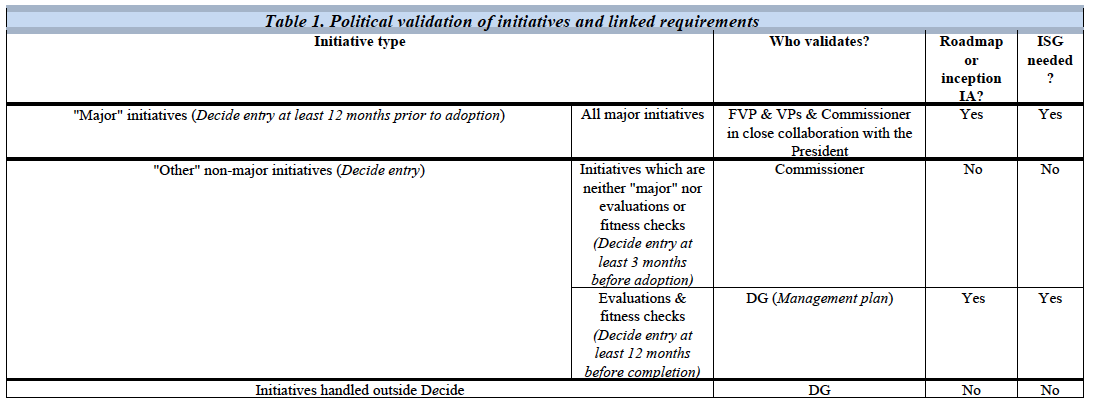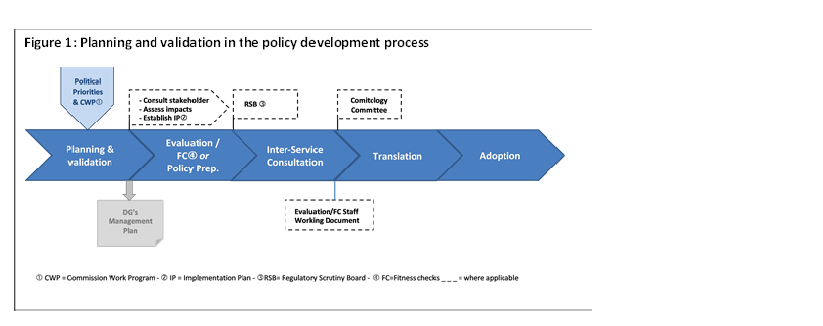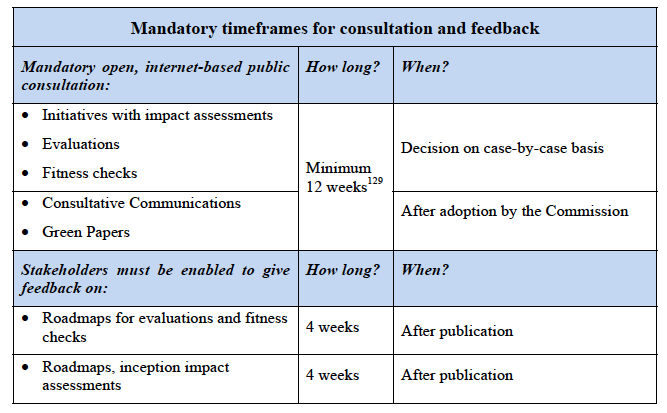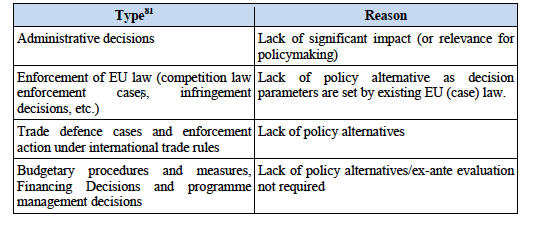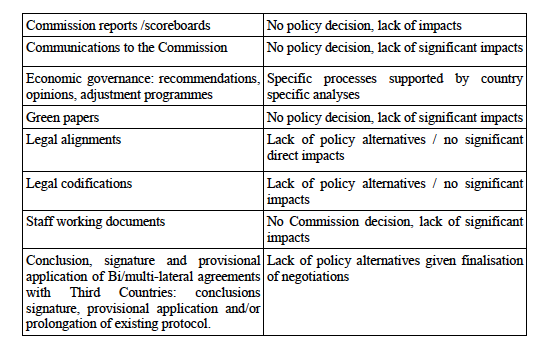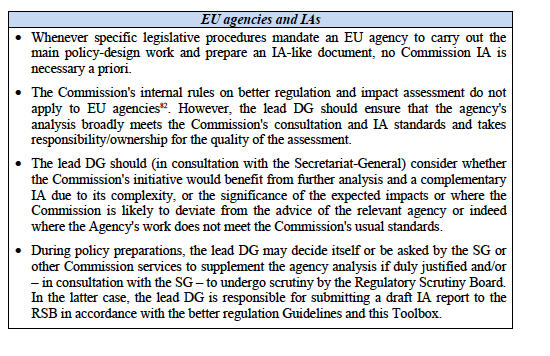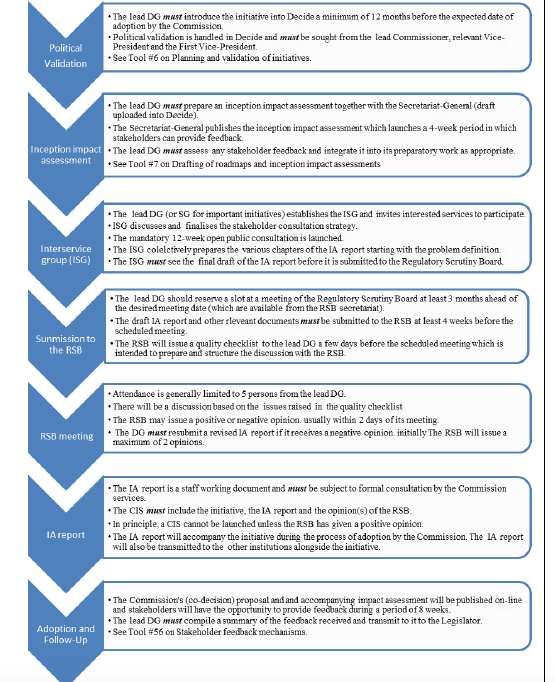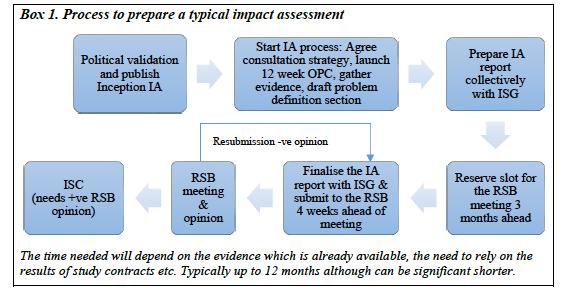The current guidelines, 19.5.2015, are here. They are 91 pages long. They are supported by a Toolbox (here) of 414 pages. This rule book has been updated. It has been transmitted to the European Parliament and Council. It is now 90 pages of detailed guidelines and supported by a 500 page Toolbox.
I would recommend that you read this Manual. But, in case you don’t want to, I have listed some of the most useful checklists and charts.
In Praise of Better Regulation
I have been an isolated supporter of ‘Better Regulation’. I think it is the most revolutionary and positive action of the Juncker Commission.
There is a virtue in the certainty in the preparation and development of policy and law. Bruno Leoni, in Freedom and the Law, writes about the importance of officials discretion being limited by clear rules..
The Guidelines provide a clear set of rules that any official can follow. The Guidelines are so clearly written so there should be no reason why they are not followed.
I welcome two main aspects of the Guidelines.
First, by codifying good practice it limits administrative discretion in developing new rules. It places weaker restraints on the exercise of political discretion by Commissioners, and very few on elected MEPs or Member States. Politicians and governments, as a broad class, are reluctant to have their hands tied, let alone follow basic good practice.
Second, it opens up European law making to public scrutiny. Now there is a lot of scrutiny. I am not sure how many people login into to it. I check it out every week. You can find it here.
Better Regulation is about ‘designing EU policies and laws so that they achieve their objects at minimum costs. …. It is a way of working to ensure that political decisions are prepared in an open, tranpsranet manner, informed by the best available evidence and backed by the comprehensive involvement of stakeholders’. Why anyone could be against this is beyond me, but there are many who are.
When to follow and not
Officials have to follow the steps laid out in the Guidelines. The Toolbox provides additional guidance. The Toolbox is only binding if “expressly stated”.
There are times when the Guidelines may be by-passed. These include:
- social partner agreements (see Art.155 Treaty),
- a political imperative to move ahead quickly,
- an emergeny,
- specific deadlines in legislation, or
- a need to respect security related or confidential information
If officials want to apply an exception they need to ask for this at:
- When the initiative is getting political validation
- Permission frm the Secretary-General and First Vice-President
The Guidelines are meant to be read by all ‘officials involved in regulatory activities.’ It would be interesting to know how many have.
The greatest weakness to Better Regulation is political will and time at the very highest levels of the Commission to follow and implement it. A First Vice-President who is clearly so busy and active must have little time to pick political fights with his fellow Commissioners and high ranking officials who would rather pre-determine the policy outcome from the very start than go through an exercise that may deliver results they do not like.
Key Checklists and Charts
Below I have gone through the new Guidelines and Toolbox and pulled out the 10 most useful charts and checklists.
- When is Political Validation Required?
See: Box 2. Scoping, political validation and interservice work
• Political validation is required to move beyond the informal consideration of a
possible initiative and to start the substantive prepatory work including engagement
with stakeholders.
• The level of political validation depends on the nature and importance of the inititiave.
“Major initiatives” should, in principle, be entered into Decide at least 12 months
prior to adoption by the College. They must be validated by the lead Commissioner,
relevant Vice-President and the First Vice-President before being accepted to be
included into the Commissions’ planning. “Other initiatives” should be validated by
the lead Commissioner or by the Director-General of the lead DG as appropriate.
• Political validation must be understood as giving the green light to start the
substantive preparatory work. It should not be interpreted as a decision on a particular
initiative or course of action that prejudges the outcome of any impact assessment
process, stakeholder consultation or later political discussion in the College.
• For major initiatives and for evaluations (including fitness checks), once political
validation is granted, roadmaps or inception impact assessments must be finalised
and published as quickly as possible. They explain to external stakeholders what the
Commission is considering and allow them to provide early feedback.
• Roadmaps are used for initiatives which do not require an impact assessment. The
reasons justifying the absence of an impact assessment will be included.
• Inception impact assessments are used for initiatives subject to an impact
assessment. These set out in greater detail the description of the problem, issues
related to subsidiarity, the policy objectives and options as well as the likely impacts
of each option.
• A roadmap is prepared for each evaluation or fitness check. This specifies the
context, scope and purpose of the evaluation and outlines the proposed approach.
• All roadmaps (including for evaluations and fitness checks) and inception impact
assessments are published by the Secretariat-General on the Commission’s website12
so that citizens and stakeholders are informed and can provide initial feedback
(including data and information they may possess) on all aspects of the intended
initiative and where applicable its impact assessment.
• Evaluations, impact assessments, stakeholder consultations, policy proposals and
implementation plans must be discussed collectively by the services13 within an
interservice group. It is important that all services with an interest participate
actively in the interservice work from the outset, particularly those DGs with specific
expertise (e.g. competitiveness and innovation, SME impacts, economic, social
impacts, environmental impacts and scientific/analytical methods).
• The launch of the interservice consultation must be agreed politically (in a similar way
to the validation of new initiatives). In addition, where an initiative is supported by an
impact assessment, a positive opinion of the Regulatory Scrutiny Board is required in
order for the initiative to be presented to the Commission for decision.
2. Who validates for what & the implications
3. The Planning and Validation Process – A schedule
4. The Key Questions an Evaluation Must Answer
1. What is the current situation?
2. How effective has the EU intervention been?
3. How efficient has the EU intervention been?
4. How relevant is the EU intervention?
5. How coherent is the EU intervention internally and with other (EU) actions?
5. Key Timelines for Public Consultation
6. What documents go to the Regulatory Scrutiny Board?
6.1 Impact Assessment
What?
| Note signed by the Director General of the lead DG addressed to the chair of the RSB.
? Draft IA report (SWD). ? IA summary sheet accompanying the IA report (SWD). ? Minutes of the meeting of interservice group that has been preparing the IA report immediately prior to submission of the IA report to the RSB. ? Links to where important underlying reports or studies can be found which underpin the IA report. ? Underlying evaluation SWD, if this evaluation has not been scrutinised separately by the RSB. |
When
| ? The lead DG should reserve a slot at a future meeting of the RSB at which the IA report will be discussed. In general, the slot should be reserved at least 3 months before the RSB meeting.
? This slot should reflect the envisaged timing of the political initiative, the time needed to adapt the IA report in light of the Board’s opinion(s) and the time needed to complete a formal interservice consultation and formal adoption by the College. ? The draft IA report should be submitted to the RSB at least 4 weeks before the RSB meeting where the draft IA report will be discussed. ? In a few exceptional cases, the RSB may decide that the draft impact assessment report does not need to be discussed at a formal meeting of the Board but can be dealt with via written procedure. This can only be decided on a case-by-case basis once the draft IA report has been submitted to the RSB and will depend on the quality and lack of complexity of the case at hand. |
Re-Submissions
| ? Where the RSB issues a negative opinion, the lead DG will have to incorporate the Board’s recommendations into a revised IA report, to discuss those changes with the ISG and to submit a revised report to the RSB.
? The RSB will aim to issue a revised opinion within 4 weeks following resubmission. In most cases, the opinion will be issued following a written procedure. However, the RSB may wish to hear the lead DG again in a meeting. In such cases, the RSB secretariat will organise an appropriate slot in consultation with the lead DG. |
7. Fitness Checks and Evaulations Secletced for Scrutiny by the RSB
What?
| Note signed by the Director General of the lead DG addressed to the Chair of the RSB.
? Draft evaluation SWD/fitness check report (SWD). ? Executive summary of the evaluation SWD or fitness check report. ? Minutes of the meeting of interservice group that has been preparing the evaluation report immediately prior to submission of the draft evaluation report to the RSB. ? Quality assessment discussed and agreed by the ISG. ? Any report prepared by consultants (where relevant). |
When?
| The lead DG should reserve a slot at a future meeting of the RSB at which the evaluation/fitness check report will be discussed. In general, the slot should be reserved at least 3 months before the RSB meeting.
? In line with the “evaluate first” principle, the fitness check report or evaluation SWD should usually be reviewed by the RSB ahead of the submission of the corresponding impact assessment. ? The draft evaluation/fitness check report should be submitted to the RSB at least 4 weeks before the RSB meeting that will discuss the draft evaluation SWD or fitness check report. ? In a few exceptional cases, the RSB may decide that the draft evaluation report does not need to be discussed at a formal meeting of the Board but can be dealt with via written procedure. This can only be decided on a case-by-case basis once the draft evaluation SWD or fitness check report has been submitted to the RSB and will depend on the quality and lack of complexity of the case at hand. |
Follow up
| The lead DG is expected to incorporate the Board’s recommendations into a revised fitness check report or evaluation SWD and to discuss the changes with the relevant ISG.
? A negative opinion does not prevent the launch of an interservice consultation on the fitness check report or evaluation SWD. However, the lead DG may wish to submit a revised SWD or report to the RSB. In such cases, the Board will aim to issue an opinion within 4 weeks usually by written procedure. In some cases, the lead DG may be invited to a meeting with the RSB which will be |
8. Initiatives for which the need for an IA should be assessed
|
| Revision of existing legal acts |
| Recasts of existing legal acts |
| Non-technical repeal of existing legal acts77 |
| Delegated acts (Art. 290 TFEU) |
| Implementation measures (Art. 291 TFEU) |
| Transposition of international agreement into EU law78 |
| White papers |
| Policy communications |
| Action Plans |
| Recommendations |
| Recommendations for the negotiation of international agreements. |
| Social partner agreements pursuant to Articles 154-155 TFEU79. |
| Financial programmes (i.e. all basic acts for spending programmes and financial instruments) |
9. Initiatives for which no automatic need for an Impact Assessment
9.2. Do you need an Impact Assessment when an EU Agency is Involved?
10. Key Steps ad Requirements for an Impact Assessment
10.2. Process Chart for the the typical Impact Assessment
